The Biology Project > Cell Biology > Intro. to Cell Cycle & Mitosis > Tutorial
The Cell Cycle & Mitosis Tutorial
DNA Basics
What is DNA and where is it stored?
 |
The nucleus is a membrane bound organelle that contains the genetic information in the form of chromatin, highly folded ribbon-like complexes of deoxyribonucleic acid (DNA) and a class of proteins called histones. When a cell divides, chromatin fibers are very highly folded, and become visible in the light microscope as chromosomes. During interphase (between divisions), chromatin is more extended, a form used for expression genetic information. The DNA of chromatin is wrapped around a complex of histones making what can appear in the electron microscope as "beads on a string" or nucleosomes. Changes in folding between chromatin and the mitotic chromosomes is controlled by the packing of the nucleosome complexes. DNA or deoxyribonucleic acid is a large molecule structured from chains of repeating units of the sugar deoxyribose and phosphate linked to four different bases abbreviated A, T, G, and C. We will later show how the simple structure of DNA contains the information for specifying the proteins that allow life. The process of mitosis is designed to insure that exact copies of the DNA in chromosomes are passed on to daughter cells. |
Department of Biochemistry and Molecular Biophysics
University of Arizona
April 1997
Revised: August 2004
Contact the Development Team
http://biology.arizona.edu
All contents copyright © 1997 - 2004. All rights reserved.